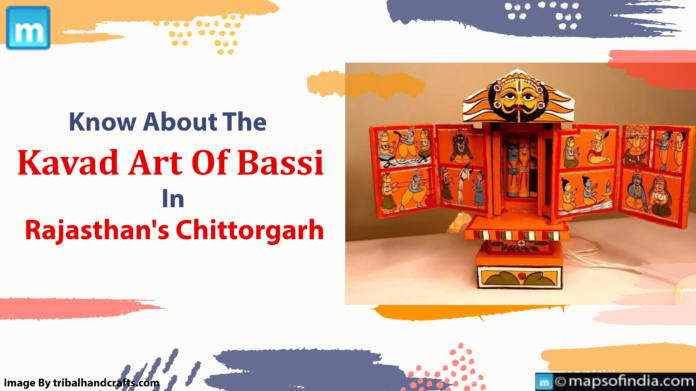Nestled amidst the historical landscape of Chittorgarh, Rajasthan lies the village of Bassi, renowned for its captivating art form – Kavad. More than just artwork, Kavad is a unique storytelling tradition, a vibrant tapestry woven with intricate details, religious narratives, and cultural heritage. This article delves into Kavad art’s essence, history, creation process, and enduring significance.
A Legacy Steeped in Storytelling
The exact origin of Kavad art remains shrouded in some mystery. Legends trace it back to the bardic tradition of the Bhopas, who used narrative paintings to accompany their epic tales. Historical evidence suggests that Kavad flourished in the 16th and 17th centuries, finding patronage from Rajput royalty. Today, the village of Bassi is the sole custodian of this traditional art form, practised by a handful of skilled craftspeople.
The Art of the Kavad
Kavad, translated to “door” or “panel” in Hindi, is a wooden portable shrine. Typically rectangular, the Kavad features multiple hinged panels that unfold to reveal a captivating narrative. The creation process itself is a meticulous dance of carpentry, painting, and storytelling:
- Crafting the Canvas: Suthar artisans, a hereditary community of carpenters, meticulously constructed the wooden Kavad frame. The size and number of panels can vary, with larger, multi-panel Kavad considered more elaborate.
- A Brushstroke of Faith: Chitrakar artists, traditionally from the Nai community, take centre stage. Using natural pigments derived from vegetables, minerals, and even cow dung, they paint the Kavad panels. The vibrant red, green, yellow, and blue hues dominate, breathing life into the stories.
- A Universe Unfolds: The central theme of Kavad art revolves around religious narratives. Deities like Krishna, Rama, and Durga are often depicted, along with scenes from Hindu epics like the Ramayana and Mahabharata. Local heroes and mythical creatures may also find themselves on the Kavad panels. Geometric patterns and floral motifs are decorative backdrops, framing the central story.
Beyond Aesthetics: Storytelling Comes Alive
Kavad transcends the realm of visual art. It’s a medium for storytelling, traditionally narrated by the Kavadia Bhat community. As the Kavad panels unfold, the storyteller brings the scenes to life through captivating narratives, engaging audiences with tales of gods, heroes, and moral lessons. The Kavad was a mobile temple used in religious processions and storytelling gatherings to foster a sense of community and cultural transmission.
A Glimpse into the Future
The future of Kavad art faces challenges. Rapid modernization and changing lifestyles entice younger generations towards other professions. However, there’s a flicker of hope. Government initiatives and growing appreciation for traditional art forms foster a renewed interest in Kavad. Artists are exploring contemporary themes while staying true to their heritage. Museums and cultural institutions are showcasing Kavad and introducing it to wider audiences.
Witnessing the Magic
If you find yourself in Rajasthan, visiting Bassi village is a must. Witnessing the creation of a Kavad, from the meticulous carpentry to the vibrant brushstrokes, is an immersive experience. Museums like the Shri Narayan Arts in Bassi showcase exquisite Kavad collections, offering a glimpse into this captivating art form’s rich history. Kavad art is more than just a visual spectacle. It is a vibrant tapestry woven with cultural heritage, religious narratives, and the spirit of storytelling.




